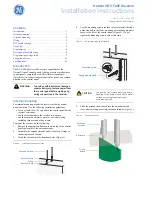
Chapter 4 SMART7 with SPAN Operation
SMART7 Installation and Operation User Manual v6
80
This azimuth is the one provided in the majority of the INS logs available to a SPAN user. See
4.6.3 ALIGN Azimuth
On SPAN systems with dual antennas, an azimuth is available from the dual antenna baseline. This is the same
azimuth that is used as an update to the SPAN solution. It is noisier than the inertial azimuth and is available at a
much lower rate, but will have a stable mean. This azimuth is computed from the master antenna to the rover
antenna based on how the antennas are oriented on the vehicle.
There is a specific subset of logs that output this azimuth. See
Table 14: Logs with Azimuth Data
Log
Log
Format
Azimuth Source
BESTGNSSVEL
NovAtel
Course Over Ground
From the best GNSS only solution
BESTVEL
NovAtel
Course Over Ground
From the best system solution which could be either GNSS or
INS
GPHDT
NMEA
ALIGN
GPVTG
NMEA
Course Over Ground
From the best system solution which could be either GNSS or
INS
HEADING2
NovAtel
ALIGN
INSATT / INSATTS / INSATTX
NovAtel
Inertial
INSPVA / INSPVAS /
INSPVAX
NovAtel
Inertial
INSSPD
NovAtel
Course Over Ground
Computed using the INS solution only
PASHR
NMEA
Inertial
Table 14: Logs with Azimuth Data
4.7 Data Collection for Post Processing
Some operations, such as aerial measurement systems, do not require real-time information from SPAN. These
operations are able to generate the position, velocity or attitude solution post-mission in order to generate a more
robust and accurate solution than is possible in real-time.
In order to generate a solution in post-processing, data must be simultaneously collected at a base station and
each rover. The following logs must be collected in order to successfully post process data.
From a base:
l
RANGECMPB ONTIME 1
l
RAWEPHEMB ONCHANGED
















































